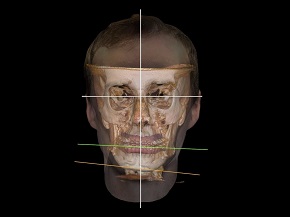Vol. 14 – Number 54 – 2021 Orthognathic Surgery Page 33-46 The integration of orthodontics and orthognathic surgery through a three-dimensional craniofacial diagnosis in a patient with facial asymmetry Luiz Felipe Rossi Tassara¹ Franciele Orlando² Sérgio Pinho² Orthodontics and orthognathic surgery aim to provide health, aesthetics and balance to the entire stomatognathic system of patients who have a facial deformity. To achieve an excellent orthodontic surgical treatment, a correct diagnosis and planning should be carried out, as well as an approach between the specialties. It has been observed that both surgery and orthodontics have evolved, and that together they can offer an effective and predictable treatment, with greater precision, less comorbidity, and also provide quality of life, health, aesthetics and balance of the entire stomatognathic system with long-term stability. Orthognathic surgery is indicated for patients who have a skeletal discrepancy that affects various craniofacial regions and is impossible to treat with orthodontics alone. It is worth mentioning that there are cases where even if the orthodontist uses skeletal anchorage, which expands the orthodontic movements, this will not be enough to solve the patient’s skeletal deficiency. These cases are considered surgical orthodontic cases and orthognathic surgery is indicated. To assess the presence of this skeletal discrepancy, diagnosis is the key to successful orthodontic and surgical treatment. Regardless of the technique or philosophy used to perform the treatment, it is through this diagnosis that the study and interpretation of data relating to a clinical problem is carried out with the purpose of determining the presence or absence of abnormality. ¹ MSc in Orthodontics – UMESP, Professor of Orthognathic Surgery and TMJ Surgery – Simetrium, Coordinator of the CTBMF Improvement Course – Odontocenter, Residency in Oral and Maxillofacial Surgery and Traumatology – PUC/BH. ² PhD candidate in Orthodontics – SL Mandic University, MSc in Orthodontics – UMESP, Professor of Orthodontics – Simetrium. ³ PhD Student – University of Barcelona, Member of the Scientific Board of the Brazilian Society of Digital Dentistry, Visiting Professor, Department of Orthodontics – University of Murcia – Spain. DOI: 10.24077/2021;1454-3346
This content is restricted to site members. If you are an existing user, please log in. New users may register below.




